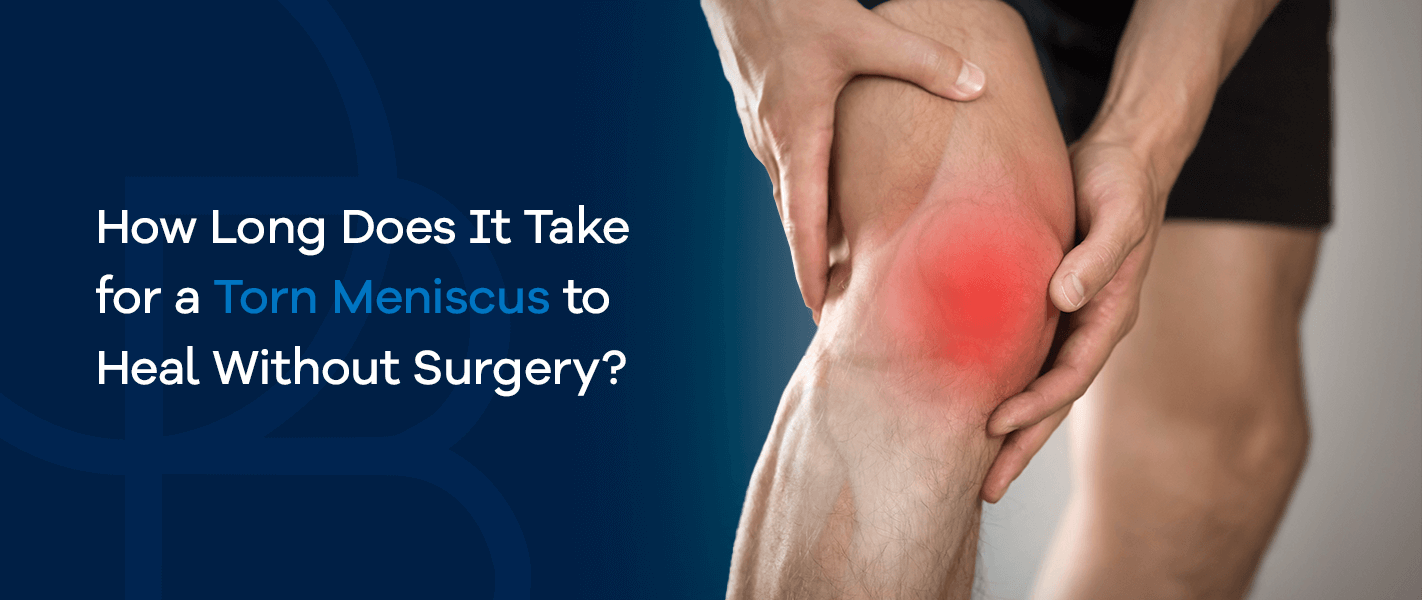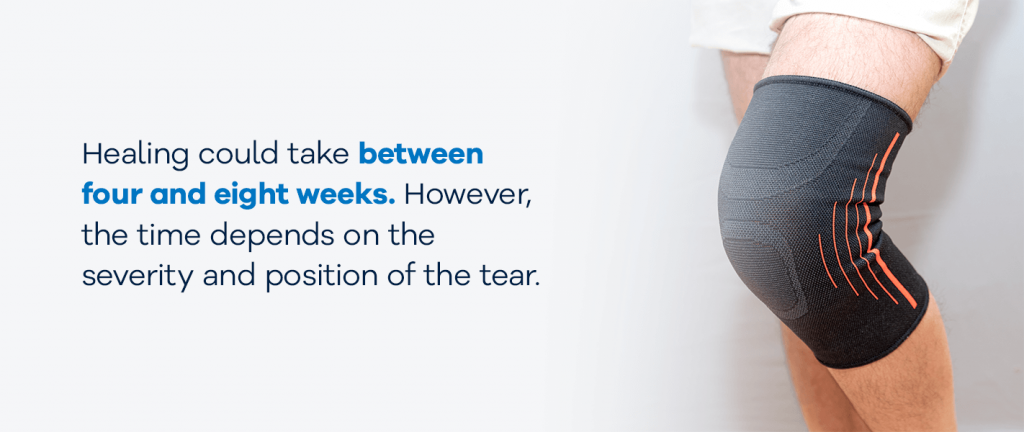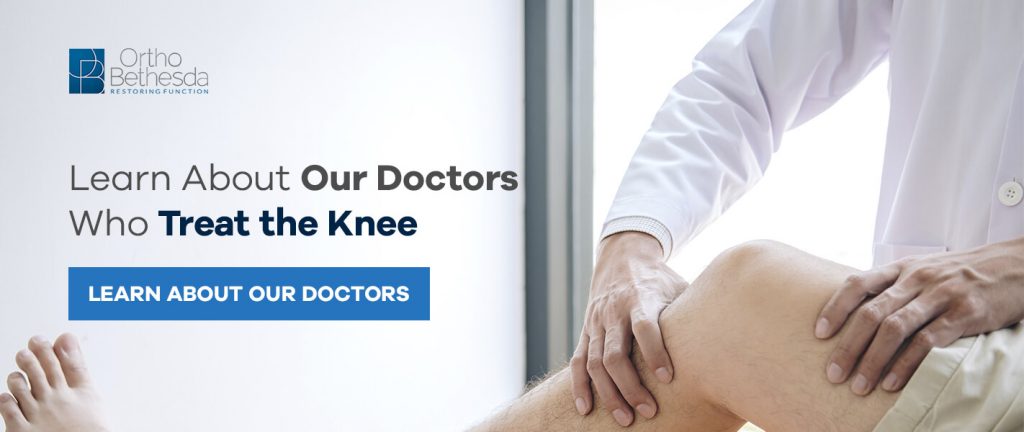
Your knee comprises three bones — the shin bone or tibia, the thigh bone or femur and the kneecap or patella. Your meniscus is a piece of cartilage that looks like a wedge or crescent. It’s rubbery and smooth and rests between the tibia and femur. You can find two menisci in each knee.
The primary function of the meniscus is to:
- Distribute weight evenly and dissipate force on the knee
- Stabilize the knee when there’s rotation
- Lubricate and cushion the joint
People of all ages can tear their menisci while performing various activities in many settings, including at home while doing simple tasks.
Minor tears, although uncomfortable, can be treated naturally at home or through physical therapy. Severe tears should not go untreated as they can create deeper issues later and require special attention to avoid further damage.
If your meniscus is torn, we want to help walk you through the road to recovery and make you aware of treatment options and recovery time.
What Is a Meniscus Tear?
A meniscus tear is an injury that happens due to the twisting motions in your knees. Meniscus tears are the most common type of knee injury for athletes. They are especially common in athletes that play football, soccer, basketball, volleyball, hockey and tennis, where they constantly bend their knees.
Meniscus tears can occur when young athletes suddenly change directions, land harshly after a jump or get direct impact from the side of their knee.
It also occurs in older patients whose meniscus has started to degenerate and is more likely to tear when twisted. The menisci act as a “shock-absorber,” and they weaken over time as people get older. Completing the same movements repeatedly as well as bearing prolonged weight can cause a torn meniscus in older patients.
A tear can be minor or complex, and complex tears usually require surgery. Similarly, if a minor tear is not healing on its own, medical attention may be necessary.
Meniscus tears can occur in three ways:
- Longitudinal: This is also known as a displaced tear or bucket handle tear.
- Horizontal: A horizontal tear is also called a flap tear.
- Radial: This type of tear is also known as a parrot beak tear.
A complex tear occurs when two of these shapes cause damage in more than one direction.
What Are the Symptoms of a Torn Meniscus?
Initially, you may not feel any pain after the tear, even if you continue playing your sport. But after one or two days, there will be pain, swelling of the knee and stiffness. The pain is not typically on the kneecap. Instead, you will feel pain on the sides of the knee. Swelling does not always occur in the exact location as the pain and usually shows the day after the injury.
Other symptoms of a torn meniscus include:
- Limping
- Popping sensation
- Feeling like your knee is “giving way” when walking
If the tear is long, it can stop you from bending your knee correctly and cause the knee to get “locked.” On the other hand, a small tear may just seem like you have an unstable knee.
When you visit our practice, we’ll examine you carefully to know whether you have a meniscus tear or not. We’ll do a physical examination of your knee and an imaging study with magnetic resonance imaging (MRI) or ultrasound.
How to Heal a Torn Meniscus Naturally
Patients frequently ask: Can you rehab a torn meniscus without surgery?
The answer is “yes,” but that’s only if the tear is not a very long one.
You need to understand what kind of tear you have because some will not heal on their own and cause more damage if left untreated.
Steps to heal a torn meniscus naturally:
- Rest: It’s crucial to rest your knee after injury. You should not participate in activities where you could cause additional strain.
- Ice: Apply ice to your knee for 15 minutes at four-hour intervals.
- Compression: To help reduce swelling, you should keep something on your leg. We may recommend using a leg cuff. If you don’t have one, an elastic band or sleeve can work as well.
- Elevation: Anytime you’re resting on a bed, chair or couch, you should use something to elevate your leg, such as a pillow.
- Medication: Taking an anti-inflammatory medication such as ibuprofen or aspirin can help to reduce swelling and pain. It’s best not to rely on them to heal you, but they can alleviate some discomfort.
- Stretch: You can stretch by lifting the knee above your heart. A doctor or physical therapist may make other stretch recommendations.
An easy way to remember the first four steps is to use the mnemonic device “RICE.” To further reduce irritation in the knee, we may recommend using crutches to limit strain, twisting and bending.
The next aspect of non-surgical treatment is physical therapy. Our physical therapist takes you through exercises that strengthen the hamstring muscles and quadriceps. Usually, for minor tears, all you need is muscle strengthening and supervised physical therapy. Your knee will function normally after the inflammation diminishes.
How Long Does It Take for a Torn Meniscus to Heal Without Surgery?
Ordinarily, your doctor or physical therapist will ask you to reduce your sports activities while your meniscus tear heals. Healing could take between four and eight weeks. However, the time depends on the severity and position of the tear. During this period, you should do strength training to strengthen your core and glute muscles. This enables you to have better control of your femur while you run.

Other factors affect how long it takes to heal your meniscus as well:
- Age
- Lifestyle
- Duration of the symptoms
A relatively healthy knee will be able to heal faster naturally than a weakened one. Because of this, older patients or those with other bone or joint issues may take longer to recover from a torn meniscus. Furthermore, if you notice that your symptoms are not decreasing as time passes, it could be because your meniscus is not healing on its own.
Remember to consult your doctor before you resume full athletic activities. You should also have another imaging test to help confirm that your meniscus has been fully restored.
Torn Meniscus Frequently Asked Questions
Whether you have torn your meniscus or you know someone who has, learning more about them will aid in the recovery process. We’ve answered some commonly asked questions to highlight the best practices to heal.
Will Walking on a Torn Meniscus Make It Worse?
In cases with acute tears, you may be able to walk around with only slight discomfort or minimal pain. However, if you’re noticing increased pain or have a severe tear, you should avoid walking on it until some pain starts to dissipate.
Some research shows that bearing weight after surgery does not cause any additional long-term damage. You can discuss with a doctor what you are and aren’t comfortable with to figure out if walking is a good idea.
What Happens if You Don’t Repair a Torn Meniscus?
Leaving a severely torn meniscus untreated could result in further damage. Some parts of the meniscus may come loose and fall into the joint. In this case, you may need knee restoration surgery to be able to use your knee again.
When left untreated, torn menisci have also been known to cause other problems, such as osteoarthritis (OA), which can further damage the meniscal structure.
Can You Make a Meniscus Tear Heal Faster?
To aid in a quick recovery, you can implement the RICE method into your daily routine.
Resting your knee will allow for quicker restoration. You can use crutches to aid in moving around without straining your knee. You should ice your knee for about 15 minutes every few hours until the swelling is gone. Using a leg cuff or elastic band to compress your knee will also help to reduce swelling and pain. When sitting or laying down, you should use a pillow to elevate your knee.
You should still expect to experience discomfort and plan to care for your knee for a few weeks, but these steps can help you recover.
Will a Knee Brace Help a Torn Meniscus?
Knee braces tend to keep your leg straight and apply a lot of pressure to your knee, which can make your tear worse. It is better to use a different form of compression, such as a leg cuff, which reduces your blood flow to the area instead.
Reducing the blood flow makes your body think it is working harder than it really is and aids in physical therapy exercises that strengthen the area.
What Aggravates a Torn Meniscus?
Aggressively twisting or rotating your knee will aggravate a torn meniscus. Direct contact on the side of the knee and landing roughly on your feet after a jump will also aggravate a torn meniscus.
Sometimes kneeling, performing deep squats, sudden stops or turns and bearing heavy weights can irritate a torn meniscus.
Doctors and physical therapists recommend that you don’t participate in sports while healing your knee and avoid participating in these activities.
Meet Our Doctors Who Treat the Knee
If you have a meniscus tear or you’re feeling pain in your knee when you perform your daily activities, schedule an appointment with our knowledgeable team here at OrthoBethesda. Our experienced surgeons specialize in specific areas of the body. So, you can be sure we know what we’re talking about when we examine you. Our team will examine your knee and inform you of the best way to move forward — literally.
Depending on the type of tear you have, we can provide non-surgical treatment. Our physical therapy enables you to heal faster and strengthen your leg muscles while reducing the risk of another tear. You can trust us to find the best solution for you.

Related Content
- How to Know If You Tore Your ACL
- How to Prevent ACL Injuries
- Top 7 Stretches to Relieve Knee Pain for Athletes
- Why Knee and Joint Pain Increase When It’s Cold
- Why Your Knee Hurts When You’re Sitting
- How to Lose Weight With Knee Pain
- Is Walking Good for Arthritis in the Knee?
- Bilateral Knee Replacement Recovery Tips
- How Much You Should Walk After a Knee Replacement
- Robotic vs. Traditional Knee Replacement Surgery
- Best Positions to Sleep in After a Knee Replacement
- Stiffness After Knee Replacement Surgery
- What to Avoid After Knee Replacement
- Is There a Best Time of the Year to Schedule Knee Surgery?
- What to Expect After a Total Knee Replacement
- What to Expect After Arthroscopic Knee Surgery
